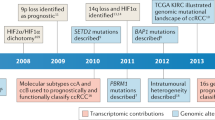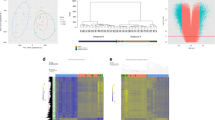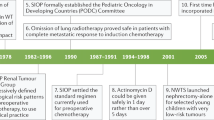Abstract
The genetics of Wilms' tumour (WT), a paediatric malignancy of the kidney, is complex. Inactivation of the tumour suppressor gene, WT1, is associated with tumour aetiology in ∼10–15% of WTs. Chromosome 17p changes have been noted in cytogenetic studies of WTs, prompting us to screen 140 WTs for p53 mutations. When histopathology reports were available, p53 mutations were present in eight of eleven anaplastic WTs, a tumour subtype associated with poor prognosis. Amplification of MDM2, a gene whose product binds and sequesters p53, was excluded. Our results indicate that p53 alterations provide a molecular marker for anaplastic WTs.
This is a preview of subscription content, access via your institution
Access options
Subscribe to this journal
Receive 12 print issues and online access
$209.00 per year
only $17.42 per issue
Buy this article
- Purchase on Springer Link
- Instant access to full article PDF
Prices may be subject to local taxes which are calculated during checkout
Similar content being viewed by others
References
Matsunaga, E. Genetics of Wilms' tumour. Hum Genet. 57, 231–246 (1981).
Miller, R.W., Fraumeni, J.F.,Jr., & Manning, M.D. Association of Wilms' tumour with aniridia, hemihypertrophy and other congenital malformations. New Eng1. J. Med. 270, 922–927 (1964).
Denys, P., Malvaux, P., van den Berghe, H., Tanghe, W. & Proesmans, W. Association d'un syndrome anatomo-pathologique de pseudohérmaphrodisme mascuiin, d'une tumeur de Wilms, d'une néphropathie parenchymateuse et d'un mosalcisme XX/XY. Arch. Fran. Ped. 24, 729–739 (1967).
Drash, A., Sherman, F., Hartmann, W.H. & Blizzard, R.M. A syndrome of pseudohermaphrodltism, Wilms' tumour, hypertension, and degenerative renal disease. J. Ped. 76, 585–593 (1970).
Wiedemann, H.R. Complexe malformatif familial avec hernie ombilicale et macroglossie- Un syndrome nouveau? J. Génét. Hum. 13, 223–232 (1964).
Riccardi, V.M., Sujansky, E., Smith, A.C. & Francke, U. Chromosomal imbalance in the aniridia/Wilms' tumour association: 11 p interstitial deletion. Pediatrics 61, 604–610 (1978).
Call, K.M. et al. Isolation and characterization of a zinc finger polypeptide gene at the human chromosome 11 Wilms' tumour locus. Cell 60, 509–520 (1990).
Gessler, M. et al. Homozygous deletion in Wilms' tumours of a zinc-finger gene identified by chromosome jumping. Nature 343, 774–778 (1990).
Pelletier, J. et al. Germline mutations in the Wilms' tumour suppressor gene are associated with abnormal urogenital development in Denys-Drash syndrome. Cell 67, 437–447 (1991).
Bruening, W. et al. Germline intronic and exonic mutations in the Wilms' tumour gene (WT1) affecting urogenital development. Nature Genet. 1, 144–148 (1992).
Pelletier, J. et al. Genetic evidence implicating the Wilms' tumour gene (WT1) in genitourinary development. Nature 353, 431–434 (1991).
Pelletier, J., Munroe, D. & Housman, D. . in Genome Analysis Vol 3: Genes & Phenotypes (eds Davies, K.E. & Tilghman, S.M.) 135–169 (Cold Spring Harbor Laboratory Press, New York, 1991).
Maw, M.A. et al. A third Wilms' tumour locus on chromosome 16q. Cancer Res. 52, 3094–3098 (1992).
Knudson, A.G. Mutation and cancer: a statistical study. Proc. natn. Acad. Sci. U.S.A. 68, 820–823 (1971).
Levine, A.J., Momand, J. & Finlay, C.A. The p53 tumour suppressor gene. Nature 351, 453–456 (1991).
Hollstein, M., Sidransky, D., Vogelstein, B. & Harris, C.C. p53 Mutations in human cancers. Science 253, 49–53 (1991).
Lowe, S.W., Schmitt, E.M., Smith, S.W., Osborne, B.A. & Jacks, T. p53 is required for radiation-induced apoptosis in mouse thymocytes. Nature 362, 847–849 (1993).
Clarke, A.R. et al. Thymocyte apoptosis induced by p53-dependent and independent pathways. Nature 362, 849–852 (1993).
Lowe, S.W., Ruley, H.E., Jacks, T. & Housman, D.E. p53-dependent apoptosis modulates the cytotoxicity of anticancer agents. Cell 74, 957–967 (1993).
D'Angio, G.J. et al. Treatment of Wilms' tumour. Results from the third National Wilms' tumour study. Cancer 64, 349–360 (1989).
Murakami, Y., Hayashi, K. & Sekiya, T. Detection of aberrations of the p53 alleles and the gene transcript in human tumour cell lines by single-strand conformation polymorphism analysis. Cancer Res. 51, 3356–3361 (1991).
Zuppan, C.W., Beckwith, J.B. & Luckey, D.W. Anaplasia in unilateral Wilms' tumour: a report from the national Wilms' tumour study pathology center. Hum. Path. 19, 1199–1209 (1988).
Oliner, J.D., Kinzler, K.W., Meltzer, P.S., George, D.L. & Vogelstein, B. Amplification of a gene encoding a p53-associated protein in human sarcomas. Nature 358, 80–83 (1992).
Ladanyi, M. et al. MDM2 gene amplification in metastatic osteosarcoma. Cancer Res. 53, 16–18 (1993).
Reifenberger, G., Liu, L., Ichimura, K., Schmidt, E.E. & Collins, V.P. Amplification and overexpression of the MDM2 gene in a subset of human malignant gliomas without p53 mutations. Cancer Res. 53, 2736–2739 (1993).
Dittmer, D. et al. Gain of function mutations in p53. Nature Genet. 4, 42–45 (1993).
de Fromentel, C.C. & Soussi, T. TP53 tumour suppressor gene: a model for investigating human mutagenesis. Genes. Chrom. Cancer 4, 1–15 (1992).
Malkin, D. et al. Germ line p53 mutations in a familial syndrome of breast cancer, sarcomas, and other neoplasms. Science 250, 1233–1238 (1990).
Srivastava, S., Zhiquiang, Z., Pirollo, K., Blattner, W. & Chang, E.H. Germ-line transmission of a mutated p53 gene in a cancer-prone family with Li-Fraumeni syndrome. Nature 348, 747–749 (1990).
Hartley, A.L. et al. Wilms' tumour in the Li-Fraumeni cancer family syndrome. Cancer Genet. Cytogenet. 67, 133–135 (1993).
Ladd, W.E. Embryoma of the kidney (Wilms tumour). Ann. Surg. 108, 885–902 (1938).
Gross, R.E. & Neuhauser, E.B.D. Treatment of mixed tumours of kidney in childhood. Pediatrics 6, 843–852 (1950).
Lemoine, N.R., Hughes, C.M. & Cowell, J.K. Aberrant expression of the tumour suppressor gene p53 is very frequent in Wilms' tumours. J. Path. 168, 237–242 (1992).
Lowe, S.W. & Ruley, H.E. Stabilization of the p53 tumour suppressor is induced by adenovirus E1A and accompanies apoptosis. Genes Dev. 7, 535–545 (1993).
Maheswaran, S. et al. Physical and functional interaction between WT1 and p53 proteins. Proc. natn. Acad. Sci. U.S.A. 90, 5100–5104 (1993).
Donehower, L.A. et al. Mice deficient for p53 are developmentally normal but susceptible to spontaneous tumours. Nature 356, 215–221 (1992).
Kreideberg, J.A. et al. WT-1 is required for early kidney development. Cell 74, 679–691 (1993).
Jackson, D.P., Hayden, J.D. & Quirke, P. in PCR — A Practical Approach (eds., McPherson, M.J., Quirke, P. & Taylor, G.R.) 29–50 (Oxford University Press, Oxford, 1992).
Sanger, A.F., Nicklen, S. & Coulson, A.R. DNA sequencing with chain-terminating inhibitors. Proc. natn. Acad. Sci. U.S.A. 74, 5463–5467 (1977).
Author information
Authors and Affiliations
Rights and permissions
About this article
Cite this article
Bardeesy, N., Falkoff, D., Petruzzi, MJ. et al. Anaplastic Wilms' tumour, a subtype displaying poor prognosis, harbours p53 gene mutations. Nat Genet 7, 91–97 (1994). https://doi.org/10.1038/ng0594-91
Received:
Accepted:
Issue Date:
DOI: https://doi.org/10.1038/ng0594-91
This article is cited by
-
Hallmark discoveries in the biology of Wilms tumour
Nature Reviews Urology (2024)
-
Differential expression profiling of onco and tumor-suppressor genes from major-signaling pathways in Wilms’ tumor
Pediatric Surgery International (2022)
-
Embryonal rhabdomyosarcoma of the uterine corpus: a clinicopathological and molecular analysis of 21 cases highlighting a frequent association with DICER1 mutations
Modern Pathology (2021)
-
Prospective use of the single-mouse experimental design for the evaluation of PLX038A
Cancer Chemotherapy and Pharmacology (2020)
-
The genetic changes of Wilms tumour
Nature Reviews Nephrology (2019)



